Handbag
A handbag, commonly known as a purse in North American English, is a handled medium-to-large bag used to carry personal items.
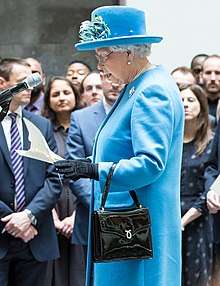
Purse, handbag or pouch
The term "purse" originally referred to a small bag for holding coins. In many English-speaking countries it is still used to refer to a small money bag. A "handbag" is a larger accessory that holds objects beyond currency, such as personal items. American English typically uses the terms purse and handbag interchangeably. The term handbag began appearing in the early 1900s. Initially, it was most often used to refer to men's hand-luggage. Women's bags grew larger and more complex during this period, and the term was attached to the accessory.[1] "Pocketbook" is another term for a woman's hand bag that was most commonly used on the East Coast of the United States in the mid-twentieth century.
Modern origin
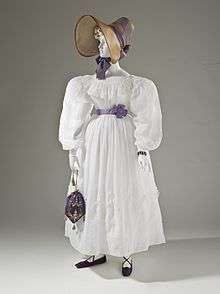
Early modern Europeans wore purses for one sole purpose: to carry coins. Purses were made of soft fabric or leather and were worn by men as often as ladies; the Scottish sporran is a survival of this custom. In the 17th century, young girls were taught embroidery as a necessary skill for marriage; this also helped them make very beautiful handbags.[3] By the late 18th century, fashions in Europe were moving towards a slender shape for these accessories, inspired by the silhouettes of Ancient Greece and Rome. Women wanted purses that would not be bulky or untidy in appearance, so reticules were designed. Reticules were made of fine fabrics like silk and velvet, carried with wrist straps. First becoming popular in France, they crossed over into Britain, where they became known as "indispensables."[4] Men, however, did not adopt the trend. They used purses and pockets, which became popular in men's trousers.[5]
The modern purse, clutch, pouch or handbag came about in England during the Industrial Revolution, in part due to the increase in travel by railway. In 1841 the Doncaster industrialist and confectionery entrepreneur Samuel Parkinson (of butterscotch fame) ordered a set of travelling cases and trunks and insisted on a travelling case or bag for his wife's particulars after noticing that her purse was too small and made from material that would not withstand the journey. He stipulated that he wanted various handbags for his wife, varying in size for different occasions and asked that they be made from the same leather that was being used for his cases and trunks to distinguish them from the then-familiar carpetbag and other travellers' cloth bags used by members of the popular classes. H. J. Cave (London) obliged and produced the first modern set of luxury handbags, as we would recognize them today, including a clutch and a tote (named as 'ladies travelling case'). These are now on display in the Museum of Bags and Purses in Amsterdam. H. J. Cave did continue to sell and advertise the handbags, but many critics said that women did not need them and that bags of such size and heavy material would 'break the backs of ladies.' H. J. Cave ceased to promote the bags after 1865, concentrating on trunks instead, although they continued to make the odd handbag for royalty, celebrities or to celebrate special occasions, the Queen's 2012 Diamond Jubilee being the most recent. However, H.J. Cave resumed handbag production in 2010.[6]
20th century
During the 1940s, the rationing of textiles for World War II led to the manufacturing of handbags made in materials like raffia[7] or crocheted from yarn. Some women crocheted their own small handbags from commercial patterns during this period.
Men's bags
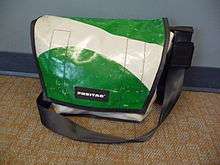
The oldest known purse dates back more than 5000 years, and was a pouch worn by a man, Ötzi the Iceman.[8] Men once carried coin purses. In early Modern Europe, when women's fashions moved in the direction of using small ornamental purses, which evolved into handbags, men's fashions were moving in another direction. Men's trousers replaced men's breeches during the course of the 18th and 19th centuries, and pockets were incorporated in the loose, heavy material. This enabled men to continue carrying coins, and then paper currency, in small leather wallets. Men's pockets were plentiful in 19th century and 20th century trousers and coats, to carry possessions, such as pipes, matches and knives, and they were an item frequently mended by their wives.[5]
Men's purses were revived by designers in the 1970s in Europe.[9] Since the 1990s, designers have marketed a more diverse range of accessory bags for men. The names man bag, man-purse and murse have been used. The designs common in the U.S. are typically variations on backpacks or messenger bags, and have either a masculine or a more unisex appearance, although they are often more streamlined than a backpack and less bulky than a briefcase. These bags are often called messenger bags or organizer bags. In many other countries, it is common for men to carry small rectangular shoulder bags, often made of leather. The leather satchel is also common. Men's designer bags are produced by well-known companies such as Prada, Louis Vuitton, Coach, and Bottega Veneta in a variety of shapes and sizes. The global men's bag and small leather goods trade is a $4-billion-a-year industry.[10] Sales of men's accessories including "holdall" bags are increasing in North America.[11]
Types
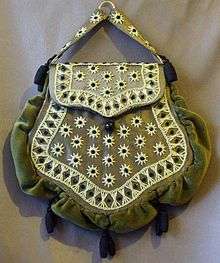
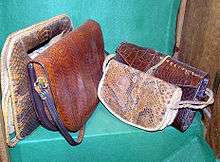
As a fashion accessory, handbags can be categorized according to the silhouette of the bag, as well as the type of handle. The current popular handbag silhouettes are (as of 2011):
- Baguette: a small, narrow, rectangular shape purse, resembling a French loaf of bread (baguette).
- Barrel: shaped like a barrel or closed tube, usually with shoulder-length straps.
- Bowling bag purse: a popular 1990s "retro" style for younger women, modelled after American bags used to carry bowling balls.
- Bucket bag: a round bag, shaped like a bucket, medium-size or large, with shoulder straps and a drawstring closure.
- Clutch: a handbag without handles with detachable chain strap, rectangular in shape, often an evening bag but used during the day as well.
- Doctor's bag: also known as a Gladstone bag, modelled after a Victorian era doctor's bag for making housecalls.
- Drawstring: a purse that closes with a drawstring at the top, may have wrist- or shoulder-length straps, popular as an evening bag style.
- Half-moon: shaped as a half-moon.
- Hobo: medium-size crescent-shaped bag with a top zipper and often a slouch or dip in the centre; a modern, casual silhouette.
- Kiondo: a handwoven handbag made from sisal with leather trimmings. It is indigenous to Kenya.
- Lighted: a handbag with a lighting system which has been attempted since the 1950s without success until recently when in 2011 the first successful lighted handbag was brought to market.
- Messenger bag: one long strap worn across the body, inspired by bags worn by urban messengers to deliver business mail, a modern silhouette.
- Minaudière: a small rectangular evening bag, usually hard-bodied, sometimes held inside a soft fabric bag that serves as a sleeve.
- Muff: a winter bag made of real or faux fur, wool or velvet that has zippered compartments and a slip opening for hands.
- Pocketbook: small purse, rectangular shape.
- Pouch: small bag such as a pocket, teabag, money bag, sporran, etc.
- Reticule: also known as a ridicule or indispensable, was a type of small drawstring handbag or purse, similar to a modern evening bag, used mainly from 1795 to 1820.
- Saddlebag: shaped like a horse saddle, may have equestrian motifs and hardware to emphasize the design.
- Satchel: a soft-sided case usually of leather.
- Tote bag: medium to large bag with two straps and an open top.
- Trapezoid: shaped as a trapezoid, usually made of stiff material.
- Wristlet: a small handbag with a short carrying strap resembling a bracelet.
According to type of handle, handbags are often categorized as:
- Tote bag: a medium to large bag with two straps and an open top.
- Cross-body bag: one long strap that crosses over the body, with the bag resting at the front by the waist.
- Sling bag: one long, wide strap that crosses over the body, with the bag resting on the back.
- Shoulder bag: any bag with shoulder-length straps.
- Clutch: handleless.
Handbags that are designed for specific utilitarian needs include:
- Laptop purse: a medium to large bag that contains a padded interior compartment or sleeve for protecting a laptop computer.
- Camera bag: for carrying photography equipment.
- Gym bag: for carrying toiletry items and the clothing and/or shoes a person intends to use for their workout.
- Cosmetic bag: a small bag for holding cosmetics, often made of synthetic waterproof protective material.
- Duffel bag: a large cylindrical bag usually used for travel or sports gear, sometimes called a "weekend bag".
- Security bag: protects the carrier from travel theft and includes an invisible stainless steel strap sewn into the fabric and a protectant on the main zipper.
- Diaper bag: carry all necessities for baby with numerous pockets including a removable changing pad.
Hardware

A distinction can also be made between soft-body handbags or frame handbags, where a metal frame supports the textile or leather of the bag. Frame bags often use a kissing lock closure, with two interlocking metal beads set on the top of the frame. Kissing locks were popular on handbags during the early- to mid-20th century, and remain popular with vintage collectors and in "retro" designs. These locks are still seen on smaller coin purses.
Coinage as a verb
The verb "to handbag"[12] and its humorous usage was inspired in the 1980s by UK prime minister Margaret Thatcher having “weaponized” the handbag in the opinion of British biographer and historian David Cannadine.[13] As “her most visible symbol of her power to command” the bag became an emphatic prop that she produced at meetings to show she meant business. She would invariably bring out of the bag a crucial document from which she would quote, her speech notes often being cut to size to fit inside. Because Thatcher was Britain’s first female prime minister, former Daily Telegraph editor Charles Moore wrote in his authorised biography of 2013, “her handbag became the sceptre of her rule”.[14]
The verb's more general meaning of "treating ruthlessly" came to symbolize Thatcher's whole style of government. Victims of her handbaggings, from political leaders to journalists, have testified[15] to what the German chancellor Helmut Kohl perceived as her “ice-cold pursuit of her interests”. US secretary of state James Baker recalled her standby ploy: “When negotiations stall, get out the handbag! The solution is always there.”
Julian Critchley, one of her biggest Tory backbench critics, once said, "Margaret Thatcher and her handbag is the same as Winston Churchill and his cigar."[16] Thatcher's bag was almost as newsworthy an item as she was herself and on the day she died, one of her handbag-makers saw a sharp rise in sales of her favorite structured design. The original bag Thatcher asserts on a signed card was the one “used every day in my time at Downing Street”[13] is archived at Churchill College, Cambridge. Made of dark blue leather “in mock-croc style”, it was a gift from friends on her birthday in 1984.
Gallery of popular silhouettes
 Bucket bag with drawstring closure
Bucket bag with drawstring closure.jpg) Vintage clutch with fold-over closure, made of red snakeskin
Vintage clutch with fold-over closure, made of red snakeskin Hobo bag with top zipper, shoulder strap, and characteristic slouch in the middle
Hobo bag with top zipper, shoulder strap, and characteristic slouch in the middle- Collection of kiondo style handbags
 Messenger bag from old truck tarp with seat belt as strap, made by Freitag, Switzerland (2008)
Messenger bag from old truck tarp with seat belt as strap, made by Freitag, Switzerland (2008) Vintage pocketbook
Vintage pocketbook Saddle shape, with equestrian hardware detail
Saddle shape, with equestrian hardware detail- Hobo bag with unique variations, such as a bold abstract print and interesting hardware
- Clutch made from eel skin, a strong but expensive alternative to cow, sheep, goat, or pig leather
 Vintage evening bag, made of ivory satin encrusted with faux pearls and glass bugle beads
Vintage evening bag, made of ivory satin encrusted with faux pearls and glass bugle beads_-_Kostuum_Accessoire_-_MoMu_Antwerp.jpg) White leather envelope bag
White leather envelope bag_-_Kostuum_Accesoire_-_MoMu_Antwerp.jpg) Brown leather handbag
Brown leather handbag_-_Kostuum_Accessoire_-_MoMu_Antwerp.jpg) Black leather handbag
Black leather handbag Lady holding a leather bag in front of eiffel tower
Lady holding a leather bag in front of eiffel tower
Gallery of traditional types
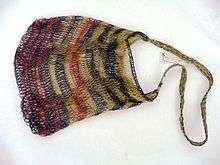 A bilum bag, used in Papua New Guinea. Bilums are made of "bush rope", cuscus fur or wool, and expand in size
A bilum bag, used in Papua New Guinea. Bilums are made of "bush rope", cuscus fur or wool, and expand in size
 Ojibwa bag with decorative beadwork; this particular bag was probably made for a child
Ojibwa bag with decorative beadwork; this particular bag was probably made for a child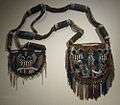
 A Burmese Kachin bag or wallet. A Figure from the booklet Burmese Textiles, published in 1917 by Laura E. Start
A Burmese Kachin bag or wallet. A Figure from the booklet Burmese Textiles, published in 1917 by Laura E. Start- A Scandinavian Sámi purse (handbag) with shoulder strap
- A Betel bag from West Timor, made around 1921. Called an aluk, such bags are still made
 A modern handbag in a traditional Hakka Chinese-style floral fabric design
A modern handbag in a traditional Hakka Chinese-style floral fabric design North African bag with lizard head and paws
North African bag with lizard head and paws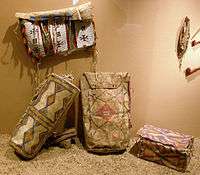 19th century bags and pouches of the Sioux
19th century bags and pouches of the Sioux- Bags exhibited in the Yunnan Nationalities Museum, Kunming, Yunnan, China
 An early 19th-century Mexican Handbag featuring a lamb and crown motif in traditional needlework and a silk dress lining. [17]
An early 19th-century Mexican Handbag featuring a lamb and crown motif in traditional needlework and a silk dress lining. [17]
Gallery of contemporary types
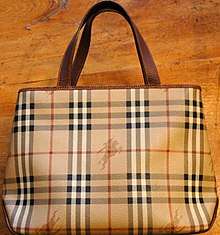 Ladies' Burberry handbag (2005)
Ladies' Burberry handbag (2005)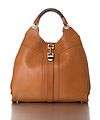 Tanner Krolle Eva bag (2006)
Tanner Krolle Eva bag (2006)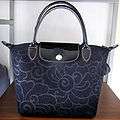 Longchamp tote bag
Longchamp tote bag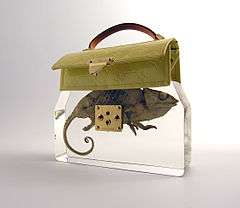 Ted Noten bag (2009)
Ted Noten bag (2009)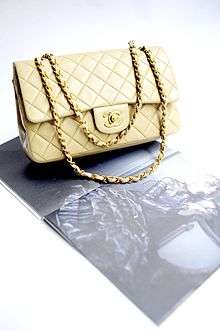 Chanel 2.55 bag
Chanel 2.55 bag- A handbag from French designer Etienne Aigner
 Handbag shaped like vintage Volkswagen bus (2007)
Handbag shaped like vintage Volkswagen bus (2007)- A classic-looking bag made from black microfiber cloth
- Crocheted bucket-style handbag by Sak.com
- Handbags at the 2010 FONART exhibition in Mexico City
 Bag made of recycled water sachets by Trashy Bags, Accra, Ghana (2012)
Bag made of recycled water sachets by Trashy Bags, Accra, Ghana (2012) Colorful handbag made from recycled materials (2012)
Colorful handbag made from recycled materials (2012) JulieApple's Yoga-a-GoGo bag made by AirDye technology that dyes fabric without the use of water
JulieApple's Yoga-a-GoGo bag made by AirDye technology that dyes fabric without the use of water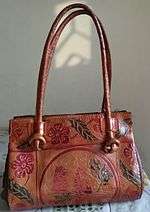 Santiniketan leather bag from India
Santiniketan leather bag from India
See also
- Chuspas
- Purse hook
- Purse organizer
- Shell purse
- ESSE Purse Museum in Little Rock, Arkansas
- Museum of Bags and Purses in Amsterdam, Netherlands
- Simone Handbag Museum in Seoul, South Korea
- Belen Echandia
- Party plan
References
- Browning, Marie (2006). Purse Pizzazz. Sterling Publishing. p. 8. ISBN 978-1-4027-4065-7.
- "Los Angeles County Museum of Art". Collectionsonline.lacma.org. Archived from the original on 24 October 2011. Retrieved 30 November 2012.
- Timmons, Henrietta. "History of Handbags- From the 14th Century to Present Day Handbag Designers". Retrieved 28 May 2017.
- Hagerty, Barbara G. S. (2002). Handbags: a peek inside a woman's most trusted accessory. Running Press Book Publishers. pp. 14–5. ISBN 0-7624-1330-1.
- Burman, Barbara; Turbin, Carole. Editors (2003). Material Strategies: Dress and Gender in Historical Perspective. Wiley-Blackwell. pp. 83–4. ISBN 978-1-4051-0906-2.
- Stockley, Philippa (2 September 2012). "Yes, the contents mean a lot, but it's the bag that matters most". The Independent. Retrieved 27 September 2015.
- Pederson, Stephanie (2006). Handbags: What Every Woman Should Know. David & Charles. p. 8. ISBN 9780715324950.
- Gerval, Olivier (2009). Studies in Fashion: Fashion Accessories. A & C Black. p. 44. ISBN 978-1-4081-1058-4.
- Sarti, Giorgio (2006). Vespa: 1946-2006: 60 Years of the Vespa. St. Paul, Minnesota: Motorbooks. p. 117. ISBN 978-0-7603-2577-3.
- Standard & Poor's (2011). Standard & Poor's 500 Guide. "Coach Inc.": McGraw-Hill. ISBN 978-0-07-175491-0.
- Clifford, Stephanie (19 February 2012). "Men Step Out of the Recession, Bag on Hip, Bracelet on Wrist". The New York Times.
- "Handbag | Definition of Handbag by Lexico". Lexico Dictionaries | English.
- Cannadine, David. "Prime Ministers' Props, Series 2, Margaret Thatcher's Handbag". BBC Radio 4, 2018-08-29. Retrieved 29 August 2018.
- Charles Moore (2013). Margaret Thatcher: The Authorized Biography, Volume One: Not For Turning. Allen Lane: London. ISBN 978-0-7139-9288-5.
- "I was handbagged by Mrs Thatcher". BBC News. Ollie Stone-Lee, 9 April 2013. Retrieved 17 June 2014.
- Alexander, Hilary (12 April 2013). "Margaret Thatcher: style, Aquascutum and the original power dresser". Daily Telegraph.
- "Purse | Mexican | The Met". The Metropolitan Museum of Art.
Further reading
- Pedersen, Stephanie (2006). Handbags: What Every Woman Should Know. Cincinnati: David & Charles. ISBN 9780715324950.